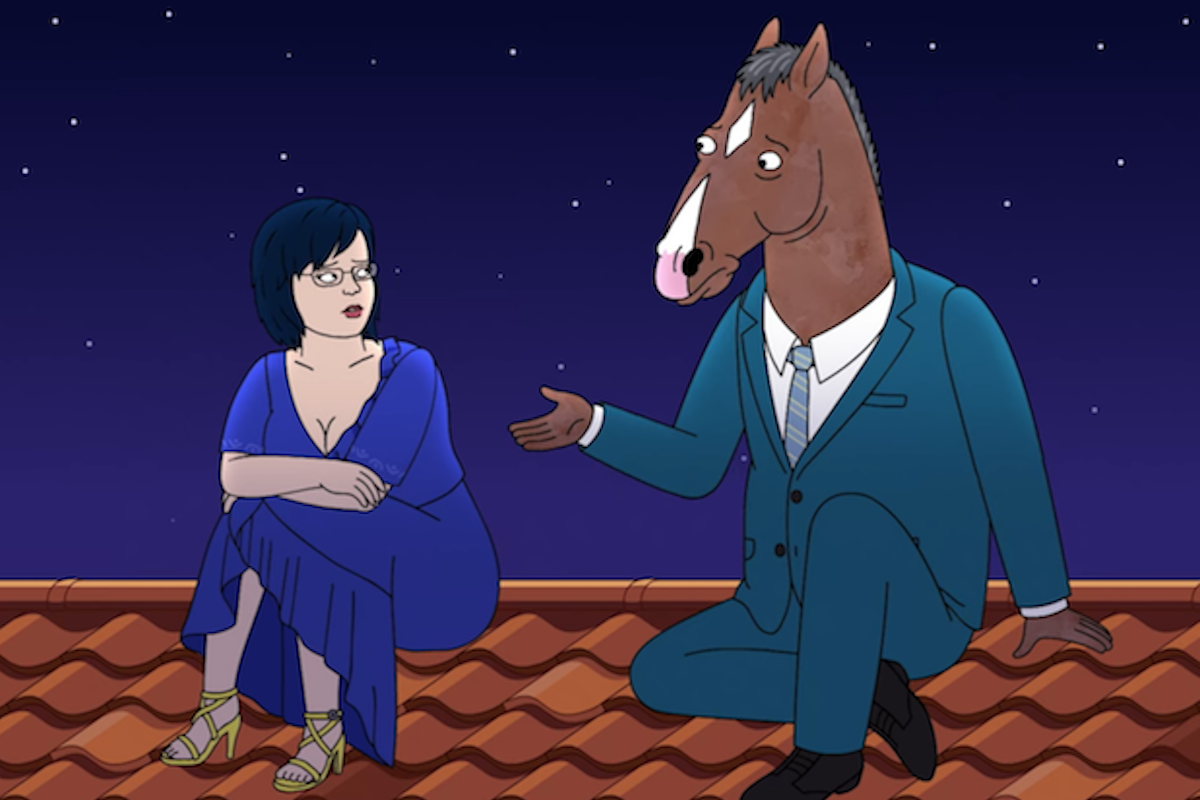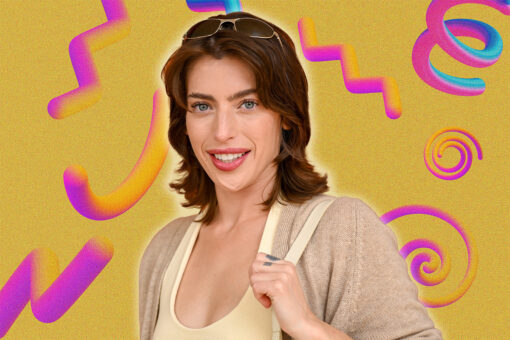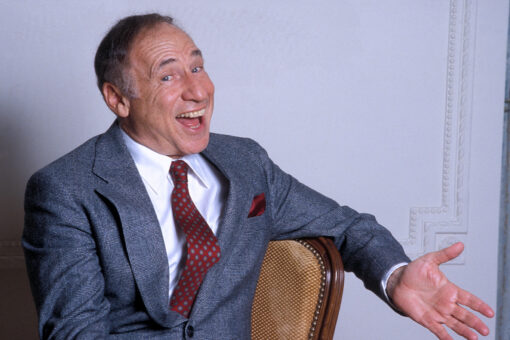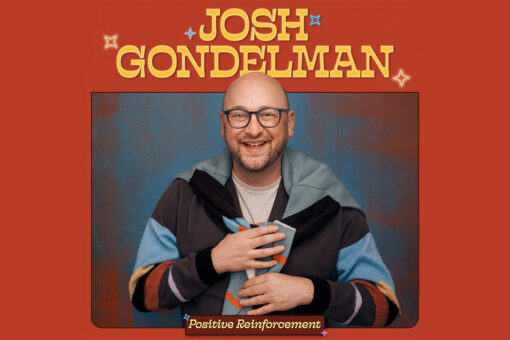As soon as BoJack Horseman first debuted on Netflix seven years ago, audiences were captured by the animated, animal-inhabited world of Hollywood it depicted. It is an easy world to fall in love with — a “Hollywoo,” as they call it, where actors, managers, writers, and producers come in all different shapes, sizes, and Animalia classifications, and who occupy and conquer their own walk of life over the show’s six-season run.
For those not familiar with the show, BoJack Horseman stars the titular humanoid horse, a washed-up sitcom star and cynical alcoholic, as he attempts to find purpose in his career and in his life. Also searching for their own life’s meaning, BoJack is joined by Princess Carolyn, a pink cat who is his agent-turned-manager; Diane Ngyuen, his human ghostwriter; Todd Chavez, a slacker — also human! — who lives on his couch; and Mr. Peanutbutter, a friendly yellow lab from a rival TV show.
One of the narrative virtues of having anthropomorphic animals for main characters is that it allows for extended world-building, both on the part of the writers and the fans. Look up any thread on Reddit or any think piece written about the show, and you’ll find dedicated fans trying to concisely sum up the rules of existing within Hollywoo — articles trying to outline the one-to-one link between the animals chosen for each character and their corresponding real-world race or ethnicity.
But at the same time, there is also a degree of arbitrariness to the matching of species to character: Can we truly conclude that Princess Carolyn is Persian just because she is a Persian cat? Because of this, it is somewhat difficult to parse through characters and stories and figure out what is a clear analogous connection and what is coincidental. However, like with any other progressive media, there are expectations to see race and religion represented — and in searching BoJack Horseman for Jewishness, we find an interesting case.
For one, the show’s creator, Raphael Bob-Waksberg, grew up in a very Jewish Californian community, with both parents working in the Jewish sphere — his mother ran a Jewish bookstore while his father helped Russian Jews immigrate to the United States. It is a past he doesn’t hide: In many interviews — notably, a very insightful talk he had with NPR in 2019 — he brings up his Jewish childhood and muses about the state of Jewish life in America.
And yet, despite having a creator who is very proud and vocal about his Judaism, BoJack Horseman doesn’t seem to have any Jewish characters.
Don’t be mistaken — there are certainly Jewish moments. In fact, there are many tell-tale signs that the show was created by a Jew, as seen by many of the references, allusions, and jokes veering towards Judaism, both cultural and religious. Mentions of Israel, the Magen David, and a pretty clever pun on “juice” controlling the media pop up in BoJack Horseman, and are delivered by a wide array of different characters, including BoJack himself.
Due to this presence of Jewish-themed language in the dialogue, the absence of a Jewish character feels even more blatant.
If you’ve watched the show, you may be asking: What about Lenny Turtletaub?
For those who haven’t had the pleasure — if that’s even the right word — of being introduced to Lenny Turtletaub, picture the absolute prototype of Jewish stereotypes. Turtletaub — as the pun name suggests: a turtle — is a Hollywoo producer who is most known for adorning practically every sentence he speaks with nonsensical Yiddish and Hebrew jargon. My personal favorite instance is when he throws in “schlemiel” and “shlimazel” into a sentence about “schmoozing,” presumably because of the shared sh sound? In fact, in this very conversation, Turtletaub’s overuse of Yiddish prompts BoJack to ask him if he is even Jewish in the first place — a question that is never actually answered in the show.
BoJack’s confusion about Turtletaub mirrors our own — are we supposed to accept that Turtletaub’s over-enthusiastic performance of Judaism makes up for the show’s seeming lack of canonical Jewish characters, or is there a more nuanced take?
When diving deeper into the stories that makes up the narrative fabric of BoJack Horseman, we find several Jewish arcs — plots that are Jewish despite the fact that they’re not attached to characters who very liberally throw out words like “schlep” and “kaput.”
The best example comes in the eighth episode of season four. In “The Judge,” Princess Carolyn and her boyfriend Ralph, who is a mouse, visit his family for the “Feast of St. Squeaky.” The holiday is in celebration of the titular mouse who defeated a tyrannical cat named King Puss Puss — and it is extremely reminiscent of the Jewish holiday of Purim.
During dinner, Ralph’s family of mice sing songs celebrating the defeat of King Puss Puss, recoiling whenever they mention his name, while wearing cat ears. During Purim, Jewish people read from the Megillah (the Book of Esther), booing whenever the bad guy Haman’s name is mentioned, while eating hamantaschen, which in its Hebrew name directly translates to “Haman’s ears.”
And then there are readings of Princess Carolyn that place her as being Jewish herself.
In the episode “Ruthie,” we learn that Princess Carolyn is the descendant of immigrants from a nondescript place referred to simply as “the Old Country.” In the animated sequence, we see a boatful of cats approach the Statue of Liberty — obviously hinting at late-19th century immigration to Ellis Island. Ellis Island welcomed a prolific number of immigrants from the 1890s to the 1950s — 12 million people, many of whom were Eastern European Jews.
And yet, the kind of immigration story depicted by Princess Carolyn’s family is shared by many groups of people who escaped to North America during times of turmoil in their home countries: Irish Catholics during the Great Famine; Arabs from the Ottoman province of Syria; Italians, Poles, and Greeks from Europe; and millions of Russian Jews escaping pogroms (the kind that Bob-Waksberg’s father helped to bring to America).
Princess Carolyn’s ambiguous identity is the perfect opposite to the over-performed identity of Lenny Turtletaub. By over-embellishing Turtletaub’s performance of Jewishness while, arguably, under-embellishing Princess Carolyn’s, the writers effectively challenge us to ask: What makes up a Jewish character and what makes up a Jewish story? And is it necessary for the two to be presented in clear connection?
We find Turtletaub’s Jewishness suspicious due to his over-zealous use of Yiddish; yet, in the same breath, we can fathom a Jewish Princess Carolyn, despite her not so much as saying oy once.
Perhaps Bob-Waksberg chose to present Jewish stories without explicitly attaching them to Jewish characters in order to allow for more ambiguity and — more importantly — more identification with the experiences of other minority groups in the diaspora. There is an excellent essay published in Bitch magazine which uses both of the episodes mentioned in this article to justify a reading of Princess Carolyn as being African American — and who’s to say she isn’t? And who’s to say there is only one reading? In a “melting pot” North America, by definition a diaspora for many people, it is not ludicrous to draw connections between experiences that minority groups share, both in their history and in the present day.
By keeping the identities of the characters vague, the BoJack Horseman writers break down the barely-there barriers that separate minorities’ stories — barriers that, due to decades of consuming and not challenging archetypal characters in our media, we have been convinced are strong and durable. But in fact, a show about a horse and a cat and a dog and two humans proves that not only are these boundaries weak, but that they are also long-overdue for being dismantled.
Image screen cap via Netflix



